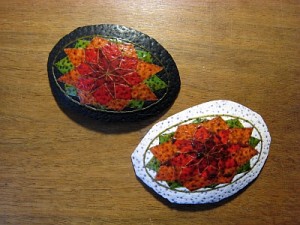You know, I believe I discover something new every time I make a batch of jewelry.
Of course, I tend to discover it at the end of my batch instead of the beginning (where I could apply it to more pieces), but – oh well. Next batch I can plan the design ahead and really experiment with this particular innovation.
When dyeing the pieces, if I have a dark color background that has not been waxed, and I want to lighten it up a bit, I usually soak the shell piece in a weak solution of bleach. I have to be careful though because the bleach can dry out the shell (much like it does my fingers). Then I brush it with an old toothbrush, maybe bleach some more until I get the result I want.
The thing about bleach and dyes, though – it doesn’t always clear out the color. Sometimes it just fades the color to a dull version. Blues are particularly hard to bleach. Black is pretty much impossible.
But – and if you have been following along – I had been using a vinegar etching technique on some brown eggs, and I wondered if it would remove the dye. So I tried it on a large oval brooch piece with the Rosette design on a black background. I poured some undiluted white vinegar into a small bowl with the shell piece inside, enough to cover the surface. Let it stew for about 5 minutes, and then removed the shell piece and brushed it lightly with a toothbrush under running water.

Voila! It worked way better than the bleach, AND was way easier on my fingertips!
The reason it works better is that it actually removes a bit of the surface of the shell. Whereas the bleach tries to alter the color. And, of course, the wax is still protecting the design, so the only thing that gets altered is the un-waxed areas.
You can see the finished products on my SHOP page.
I was so pleased, I went back to all my (hundreds!) of finished pieces to see if I wanted any more with a white background. Only found a few, but – as I said – next batch I’ll work with the technique a little more.
So, I learned a few things with this experiment:
(1) The dyes only penetrate the very surface of the eggshell. Previously, I thought the dye saturated the shell.
(2) The dye remains in the little eggshell dimples and makes an interesting spotty effect that enhances the surface pattern. And,
(3) Buy more white vinegar.